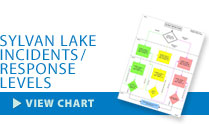Sylvan Lake EAP Case Study
Sylvan Lake EAP Case Study

Sylvan Lake team finds efficient, mostly 'painless' path to IEAP benefits
Dam Owners, Emergency Manager, Engineers Say IEAP Process Informative and Rewarding
When the Ice Age came to a close and the last glacier withdrew from Indiana, it left behind a gouge and a river system that about 12,000 years later, with some human intervention starting in 1837, would create one of the many scenic lakes that dot the northeast area of the state between Fort Wayne and South Bend.
The Dam and the Lake
Today the 669-acre Sylvan Lake has houses and boat docks around its perimeter, and the town of Rome City is near its dam. The woodlands, hills and marshes in the watershed feed 5,985 acre-feet of water into the lake at normal pool. State Highway 9 traverses the dam that forms the lake’s northwestern boundary. Development of houses and businesses downstream of the dam has given the dam a designation of High-Hazard Potential (HHP) because a breach would almost certainly take human lives. In fact, the dam already has taken three lives, when it failed in 1844, the second of three failures within a few years of its initial construction. Later there would be at least two near-failures before reconstruction and improvements in 1996 and afterward resulted in the addition of a Tainter gate, spillway improvements, and other stabilization actions.
Sylvan lake is on the Middle Branch of the Elkhart River and is located above a chain of West Lakes in sequence or adjacent to one another. Heavy rains at various times in recent years have brought the lake to high levels, but have not progressed beyond the stage of monitoring the dam and lake levels very carefully. The dam was owned by private home owners, the Sylvan Lake Association, Noble County Commissioners and the State of Indiana prior to reconstruction of the dam in the 1990s. The Rome City Conservancy District was then formed and took ownership of all the dam properties along with the maintenance and care of the dam in perpetuity.
A Conservancy District is a legal mechanism by which landowners, through a circuit court process, can organize a special taxing district as a local unit of government to solve specific local issues related to water resources management. With Sylvan Lake it was a means to take ownership of the dam and raise the funds to maintain it and pay for improvements necessitated by its hazard classification. The District levies an assessment on about 750 property owners who benefit from the lake and the dam. The lake is an "Indiana Natural Lake," ownership of which is held in a state public trust under the Indiana Lakes Preservation Act. The separate Sylvan Lake Improvement Association of homeowners is involved with maintaining the quality of the lake as well, particularly its recreational, community, and aesthetic qualities. The Indiana Department of Natural Resources (DNR) has regulatory oversight of lakes held in trust, and the Indiana Lakes Management Work Group makes decisions regarding recreational usage, permits, water quality, and environmental matters.
The Team
DNR prefers the term Incident and Emergency Action Plan (IEAP) to underscore the fact that in most circumstances planning for and managing an "incident" with a dam will prevent it from turning into an emergency. Indiana law does not require an IEAP on state-regulated HHP dams, even those for lakes the state holds in trust, but concerns about public safety, liability, and responsible governance led the District's board to the conclusion that an IEAP was needed. The team that worked on the project for several months concluding in 2003 was led by:
- Leigh Ann Pranger, Rome City Town Manager and Secretary for the Rome City Conservancy District.
- Siavash Beik, Vice President and Principal Engineer, Christopher B. Burke Engineering, LLC, Indianapolis. He also was head of the DNR Dam Safety Program from 1990-93.
- Michael P (Mick) Newton, Director, Noble County Emergency Management Agency.
- David Nance, Engineering Geologist in the Project Development Section of the Division of Water.
Additional participants included the Noble County Sheriff, the Rome City Town Marshal, an Indiana DNR Conservation Officer, representatives from the Indiana Department of Homeland Security and the National Weather Service, leaders of the Sylvan Lake Improvement Association, board members of the Conservancy District, and the District's outside on-call engineer from Geosyntec Consultants.



